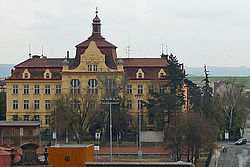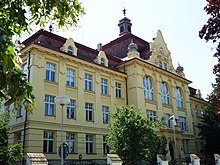Gymnasium (Žatec)
| Žatec high school | |
|---|---|
 Gymnasium (Žatec) |
|
| type of school | high school |
| founding | 1807 |
| address |
Studentská 1075 |
| place | Žatec |
| region | Ústecký kraj |
| Country | Czech Republic |
| Coordinates | 50 ° 19 '19 " N , 13 ° 32' 46" E |
| carrier | Ústecký kraj |
| student | about 360 |
| Teachers | 29 |
| management | M. Řebíček |
| Website | www.gymnaziumzatec.cz |
The grammar school in Žatec (German Saaz) goes back to the Latin school founded in 1256, which was under the direction of the scholar Johannes von Saaz from 1386 to 1411 and was run by the Premonstratensians from the Strahov Monastery until 1777 . It was not officially founded as a municipal school until 1807 in a building in downtown Saaz. The grammar school has been located in a representative building in the Prague suburb in the southern part of the city since 1903.
history
The origins of the Saaz high school go back to the Latin school founded in 1256. In 1335, a decree issued by King John of Luxembourg confirmed the city's right to appoint the school's rector. From 1386 to 1411 this Latin school was under the direction of the scholar Johannes von Saaz , the author of the poem " The Plowman from Bohemia ".
In 1515, King Ladislaus Jagiello gave the right of patronage over the Church of the Assumption and the local school to the Premonstratensians of the Strahov Premonstratensian Monastery . With interruptions due to the Reformation, the school was run by the Premonstratensians until 1777 after the Battle of White Mountain .
In the time of humanism , the Saaz school had an excellent reputation. Daniel Adam of Veleslavin described it in 1579 together with the schools in Laun ( Louny ), Hradec Kralove (Hradec Králové) and Leitmeritz (Litoměřice) as the best in the country Bohemia. In the 16th century, various humanistic scholars such as Georg Ostracius or Peter Codicillus von Tulechova taught at the Saaz grammar school. He wrote in Latin "An elegiac poem about the Saaz school" (Schola Zatecensis), which had been renewed after the plague, which was printed in 1575. The school principal Jakob Strabo had drawn up a new school plan for the “Schola Zatecensis Strabonis Glatovini” in 1575, which was printed by the University of Prague in 1586 and 1600 and was binding for high school teachers in all of Bohemia.
The school building was located near the main church of the city next to the rectory, where today's buildings No. 132 and No. 542 are located. The location is recorded in a view of the city of Saaz from 1602 by Jan Willenberg (1571–1613), today in the regional museum. After state funding ceased in 1777, classes took place in the dean's office.
In the early 19th century, the city's efforts to restore the school were successful, mainly through a foundation by Katharina Andree, the school's funding was secured. In October 1806, Emperor Franz II confirmed the reopening of the Saaz high school as a public institution. The school was inaugurated in the city center on Floriansplatz (today Platz des 5 Mai) in the rooms of a former brewery (house no. 127) on November 3, 1807. The grammar school was located in this building from 1807 to 1903.
From 1818 to 1852 it was expanded from a 5-class to an 8-class grammar school. The language of instruction was German. In the years 1826-1850 the school was attended by about 100 to 200 students. From 1849, Latin, Greek, history, German, mathematics, biology, physics and philosophy became compulsory subjects. Czech was among the compulsory elective subjects, but has been compulsory since 1904. In 1873 it was converted into a state high school, the name was: Imperial-Royal State Upper High School in Saaz (Bohemia).
Until the First World War , the proportion of Czech students was only about 5%. In 1901 the city of Saaz issued a public tender for the construction of a new high school building. The jury (a member of the jury was the architect of the Prague National Theater Josef Zítek) selected a project by the architect Ernst Schäfer from Reichenberg (Liberec). In December 1903 the inauguration of the new building took place, in which the high school is housed until today. The school was named: Kaiserlich-Königliches Kaiser-Franz-Joseph-Staatsgymnasium in Saaz. The imposing building is a unique monument of Art Nouveau architecture and a landmark of the city that can be seen from afar. Above the main entrance was written in large letters "Live to learn - Learn to live".
After the establishment of the First Czech Republic , the focus shifted from the classical grammar school to the secondary school. Czech has been a compulsory subject since 1923 and girls were also admitted. A high proportion of the pupils were Jews who left school and the city of Saaz in 1938 after the Sudetenland was annexed to the German Reich. The numerous Jewish professors or those who were married to Jewish women were removed from the school. These teachers were replaced by student councilors from Saxony.
At the end of 1938, the grammar school became a “high school for boys” (through a Reich regulation), but girls were also allowed to attend. From the school year 1939/1940 there was a change in the school system. The Reich German school system was adopted, according to which the pupils had to switch to the grammar school after the 4th grade (not after the 5th grade as before). From 1942 the school was called "Ackermann-Oberschule", named after the famous work of Johannes von Saaz. As a result of the war events in the school year 1944/1945, school operations were closed in February 1945. This ended the history of the German high school in Saaz.
After the war, classes began again in September 1945. The now Czech grammar school had around 150 students, a third of whom were girls. About a third of the students were children of the resettled Volhynientschechen . After the February coup of 1948, the eight-class grammar schools were dissolved and replaced by four-class high schools.
From 1953, the eleven-class middle school was integrated into the high school, and from 1960 it was a secondary comprehensive school. Later there was also vocational training in agriculture, construction and economics. The original name "Gymnasium" was only reintroduced after the reforms of the 1968 Prague Spring .
In order to improve the physical education at the grammar school, a new sports field was built opposite the school building, actively supported by the students under the direction of Karl Heidenreich. The sports field was put into operation in 1965. Between 1973 and 1975 the building was renovated and the windows were provided with new stained glass according to a design by the architect Fanta .
The social changes in 1990 affected personnel issues, organizational forms and training. The school administration is now the Ústecký kraj (Aussiger district). The high school has z. Currently about 300 students and 29 teachers (20 women, 9 men). There is a four-year form (after the 9th grade) and an eight-year form (after the 5th grade) of the training. A school partnership exists with the Goethe-Gymnasium in Reichenbach in Vogtland .
principal
Until 1849 the headmaster was referred to as "prefect", then as rector, until 1873 the rectors were members of the Premonstratensian order.
- until 1528 Nikolaus Czernobyl († February 24, 1556)
- 1531–1543 Valentin Mezerczycz († 1543)
- until 1564 Wenzel Arpin von Dorndorf († February 1, 1583)
- until 1575 Georg Ostracius († February 19, 1575)
- 1575–1582 Jakob Strabo († Sept. 11, 1582)
- until 1600 Martinus Bachacius (Martin Bacháček z Nauměřic) († February 17, 1612)
- 1600–1604 Laurentius Benedikt von Nudožer (Nudožerinus) († June 4, 1615)
- 1605–1607 Hieronymus Veit Netoliczky († 1617)
- until 1807 Thomas Matzek († July 27, 1807)
- 1807–1817 Franz Theofil Singer
- 1817–1830 Wenzel Neubronn, Baron von Eisenburg
- 1830–1833 Evžen Šrámek (Eugen Schramek)
- 1833–1853 Alois Dostal
- 1853–1873 Oswald Josef Müchel
- 1873–1899 Josef Hollub
- 1899–1909 Wendelin Toischer
- 1909–1910 Alois Zoller
- 1910–1921 Karl Kaplan
- 1921–1922 Emmerich Wippermann
- 1922–1927 Richard Schramm
- 1927 Franz Kühnl
- 1927–1934 Augustin Potuček
- 1934–1935 Ernst Mändl
- 1935–1938 Leopold Mogan
- 1938–1939 Franz Egerer
- 1939–1943 Alfred Jäckl
- 1943–1945 Franz Egerer
- 1945–1948 Josef Mikeš
- 1948–1949 Jiří Svoboda
- 1949–1951 Ladislav Jebavý
- 1951–1957 Josefa Pudilová
- 1957–1959 František Hladík
- 1959–1970 Jiří Cihla
- 1970 František Týřl
- 1970–1973 Milan Zeman
- 1973–1983 Josef Paur
- 1983–1990 Hana Henrychová
- 1990–1991 Jiří Cihla
- 1991-2005 Jaroslav Hašek
- 2005– today Miroslav Řebíček
Known teachers
- Georg Bruder (1856–1916), b. in Innsbruck, geologist, teacher from 1890 to 1893, author of numerous scientific studies, a. a. about the tertiary limestone deposits at Tuchorschitz (Tuchořice).
- Helmut Preidel (1900–1980), b. in Bodenbach (Podmokly), archaeologist, teacher from 1932 to 1939, editor-in-chief of the German archaeological journal Sudeta, his specialty was the settlement of Bohemia by Slavs and Germans.
- Zdeněk Svěrák (* 1936), b. in Prague, playwright, actor, copywriter, screenwriter, novelist, teacher from 1960 to 1962.
Known students
- Karel Rafael Ungar (1744–1807), b. in Saaz ( Žatec ), important enlightener, since 1780 administrator of the library of Charles University in Prague, 1789/1790 university rector.
- Milo Jan Nepomuk Grün (1751-1816), b. in Flöhau ( Blšany ), theologian and historian, abbot of the Strahov monastery since 1804 , rector in 1812, author of theological books and the history of Bohemia.
- Anton von Banhans (1825–1902), b. in Michelob ( Měcholupy ), economist, politician, member of the Imperial Council, from 1870 to 1875 Minister of Agriculture and Trade, since 1890 President of the Society for Danube Steamship.
- Adolf Seifert (1826–1910), b. in Weletitz (Veletice, OT von Holedeč ), historian and doctor, Matura 1844, he has written four books on the history of Saaz.
- Emanuel Zaufal (1837–1910), b. in Puschwitz ( Buškovice ), ear doctor of European importance. Matura 1857, founder of the ENT clinic in the General Hospital and at the Karl Ferdinand University in Prague.
- Emil Holub (1847–1902), b. in Holitz ( Holice ), Africa researcher and ethnographer, Matura 1866, he was twice in Africa, author of several books and scientific studies.
- Karl Kreibich (1869–1932), b. in Prague , doctor, Matura 1888, from 1903 to 1906 he headed the Dermatology Clinic in Graz, since 1906 head of the dermatological clinic of the medical faculty of the German University in Prague, 1923/1924 elected rector of this university.
- Wilhelm Wostry (1877–1951), b. in Saaz (Žatec), historian, Matura 1896, since 1927 professor of Bohemian history at the German University in Prague, chairman of the Society for the History of Germans in Bohemia, author of scientific publications, including "Saaz at the time of the peasant poet" (1951) .
- Hans Karl Zeßner-Spitzenberg (1885–1938), b. in Dobrichan , lawyer, Matura 1903, employee of the State Chancellery in Vienna, professor of constitutional and administrative law, victims of National Socialism.
- Karel Reiner (1910–1979), b. in Saaz (Žatec), composer, studied with Alois Hába and Josef Suk , from 1964 to 1969 he was chairman of the Czech Music Fund.
Individual evidence
- ↑ http://www.saazer-heimatmuseum.de/neuheiten/saaz-geschichte-einer-deutsch-bohmischen-stadt/
- ^ Matyáš, Jiří a kol., Dějiny Žateckého gymnázia. Schola Zatecensis, Regionální muzeum v Žatci, Žatec 2009, ISBN 978-80-86971-85-8
- ↑ Archive link ( Memento from March 5, 2016 in the Internet Archive )
- ↑ Gymnázium Žatec - Historie školy (Czech) (accessed on April 13, 2018)
- ^ Archeology in North West Bohemia - Helmut Preidel (Czech) (accessed December 25, 2015)
- ↑ http://austria-forum.org/af/AEIOU/Zessner-Spitzenberg,%20Hans%20Karl%20von


